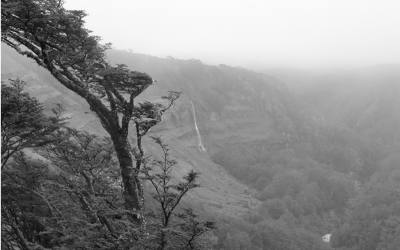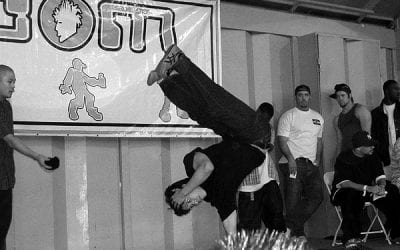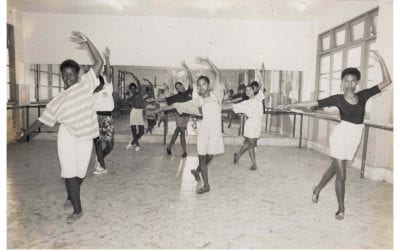The Flight of a Moment

“Cours public du ballet national de Cuba (Grand Palais)” by dalbera is licensed under CC BY 2.0
Dancers are often thought to move their muscles, yet neglect to develop their brains. Dance is absent from most academic studies. Perhaps this is because dance takes place in the flight of a moment. It cannot be placed on a wall, filmed for television or recorded for later listening pleasures. It is something alive and vivid—something that can show national identity or its evolution in history.
Cuban choreographer and dancer Ramiro Guerra, like many other dancers in Cuba, is interested in the intellectual pursuit of dance. Guerra, credited with helping create Cuba’s distinct modern dance, discusses and writes about the subject of dance from an academic perspective. Cuba’s modern dance is a syncretization of techniques from ballet, North American modern dance from the schools of Graham, Humphrey, and Límón, as well as social and sacred dances and rhythms derived from Africa reflecting the island’s history. Modern dance, a relatively new development in Cuba, came into being as a more formal set discipline following the 1959 revolution, almost a decade after Latin America’s first modern dance movement in Mexico in the 1950s. Modern dance technique with this Cuban flare emerged as a result of this mixture of influences, and is apparent in the country’s first modern dance company, Danza Contemporánea de Cuba.
Now, modern, post-modern, and dance theater have found a place in the Cuban dance scene in festivals such as the Festival de Danza en Paisajes Urbanos (Festival of Dance in Urban Spaces). Only fifty years ago, teachers from abroad traveled to Cuba to teach in the newly formed art schools of ENA (Escuela Nacional de Arte—National Arts School) and ISA (Instituto Superior de Arte—Institute of Superior Art). Cuba has now taken the lead by producing an amazing amount of talented dancers, teachers and dance intellectuals, as well as doing something that few countries have been able to do successfully—making dance available to the public.
Cuban dancers and teachers are dispersed throughout the world. Every great ballet company has Cubans as principal dancers and every salsa showcase is bound to have Cuban members. Perhaps Afro-Cuban folklore traditions in the dances of the Orishas, movements of the members of Abakuá, and variations of rumba (columbia, guaguancó, or yambu) may be familiar to some. However, little is publicized about modern and post-modern dance in Cuba nor the equally impressive schools producing these skilled dancers and choreographers.
The ENA began shortly after the revolution with programs in music, theater, dance, photography, fine art and film. It was a product of the promotion of la cultura (the culture) by the new government. The idea of la cultura increased the education and knowledge of arts, as well as creating space for folklore traditions among the respected arts forms. ENA’s founding attracted dance teachers from the United States as well as Mexico. (Today, though, it is Cuba that sends its professors throughout the world.) These teachers helped to instill a profound base in modern techniques such as Graham, Humphrey, and Limón that would later develop a Cuban touch in the addition of a conga drum and distinct African derived movements. One such teacher, Alma Guillermoprieto, wrote Dancing With Cuba, a memoir about her experience during the ENA’s initial years. (Guillermoprieto, now an acclaimed writer, is also a former Nieman and Radcliffe Fellow at Harvard).
For years, children have been chosen in auditions throughout Cuba to study dance six years at the ENA in Havana. All is provided for these students—everything from the black leotards and red hair ribbons to snacks of the ever-present pan con lechón (roast pork sandwiches). The curriculum consists of academics, including the history of dance and music, as well as dance classes in ballet, Cuban modern and folklore.
Unlike public art high schools in the United States where students come with previous experience, Cuba offers an arts education to those with talent or promise and not just to those lucky enough to have had the opportunity and/or money to receive prior training. Yet, the ENA expects (and the students follow suit) that all are heading for a career in the arts. Following one year of mandatory public service, most will enter dance companies or will continue to teach at small schools in the provinces. Some students may enter modern or folklore companies (ballerinas study in a separate specialized ballet school to enter the national ballet); yet not all manage to enter the top companies with a chance to travel. Traveling with dance companies appeals to dancers because it offers offering perks of extra income and thus a more comfortable life within Cuba. Other dancers are offered options with second tier troupes, as teachers, or within arts organizations. Unlike dancers in the United States, even second tier dancers in Cuba can work in within the dance world and are paid with a normal Cuban salary.
Following the public service year, dancers wishing to continue their studies and become accredited teachers must attend the university version of the ENA, the ISA. The ISA is on the same property as the ENA, which was once a country club for Cuba’s rich. However, now, the river and green rolling hills are filled with the sounds of trumpets, drums, and guitars as students practice their skills under slender palm trees and building awnings. The environment is something of an artist’s utopia, drawing on nature and other artistic forms for inspiration. Even the ISA’s dance department’s buildings, designed by the architect Ricardo Porro, with their melon shaped roofs and pointy centers resembling plump breasts, meld the body into nature.
ISA professors such as Lourdes Ulacia encourage her students to experiment in their dancing. Her combinations change direction, angles, and rhythms requiring the dancers to think about space, time, and expression in ways to which they may not be accustomed. Her choreography is smart in the way that the patterns morph and keep dancers on their toes. While the lower half of the students’ bodies may be warming up with tendues and other contained ballet steps, the upper bodies undulate and sway in ways only seen in Afro-Cuban folklore. All the while a lone drummer follows the dancers movements adding intensity or soft caressing where needed.
In addition to the schools, festivals highlight modern dance. In 1987, the dance/theater company, Danza Teatro Retazos, began the Festival de Danza en Paisajes Urbanos: Habana Vieja, Cuidad en Movimiento (Festival of Dance in Urban Spaces: Old Havana, City in Movement) dance festival which made modern dance even more accessible to the public. The free festival, also called the Callejera (Street Festival), also created gave a space for tango, flamenco, ballet, folklore, experimental and hip hop. This festival, open to all participants, brings together the best (and worst) of dance throughout Cuba as well as groups from throughout the world and as far away as New Caldonia!
The week of performances, classes, lectures, and parties led to collaboration and an exchange of ideas uncommon in the dance world. Dancers were thinking of dance in new ways that were not purely physical. A dancer performing the movements of the orisha Oya recited passages from Cuban writer Fernando Ortiz about Cuban identity. From there, Oya began to leap and contract and suddenly transformed into the modern dancer with a distinctly and unmistakably Cuban movement aesthetic. While it is common in Cuba for the audience to explode into applause and screams at the ballet, Oya at the modern dance festival surprisingly received those same shouts of adoration for her performance.
Cuba has created a very special dance and artistic environment that seeps into other sectors of Cuban society. Because dance is alive and accessible in Cuba, Ramiro Guerra is able to write about dance for the greater Cuban population. Perhaps with the lead of dancers such as Guerra, Cuba will begin to lead other dance communities to begin understanding dance in an intellectual context.
Related Articles
Editor’s Letter: Dance!
We were little black cats with white whiskers and long tails. One musical number from my one and only dance performance—in the fifth grade—has always stuck in my head. It was called “Hernando’s Hideaway,” a rhythm I was told was a tango from a faraway place called Argentina.
Brazilian Breakdancing
When you think about breakdancing, images of kids popping, locking, and wind-milling, hand- standing, shoulder-rolling, and hand-jumping, might come to mind. And those kids might be city kids dancing in vacant lots and playgrounds. Now, New England kids of all classes and cultures are getting a chance to practice break-dancing in their school gyms and then go learn about it in a teaching unit designed by Veronica …
Dance Revolution: Creating Global Citizens in the Favelas of Rio
Yolanda Demétrio stares out the window of our public bus in Rio de Janeiro, on our way to visit her dance colleagues at Rio’s avant-garde cultural center, Fundição Progresso. Yolanda is a 37-year-old dance teacher, homeowner, social entrepreneur and former favela (Brazilian urban shantytown) resident. She is the founder and director of Espaço Aberto (Open Space), an organization through which Yolanda has nearly …




